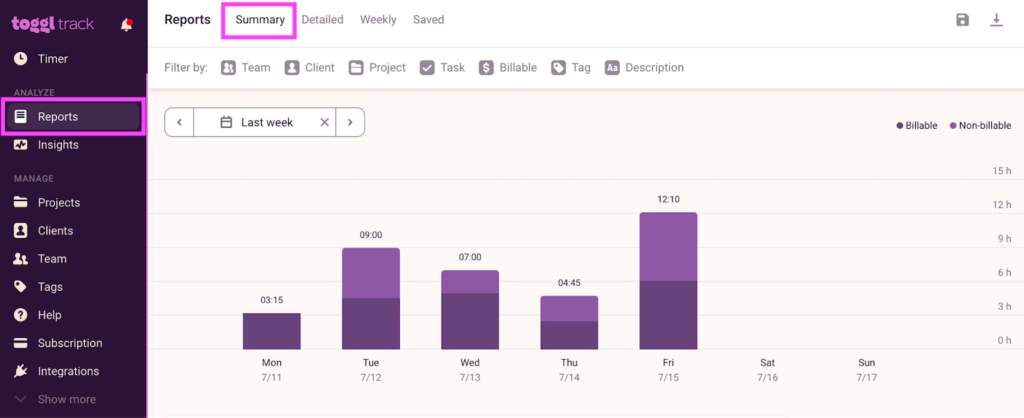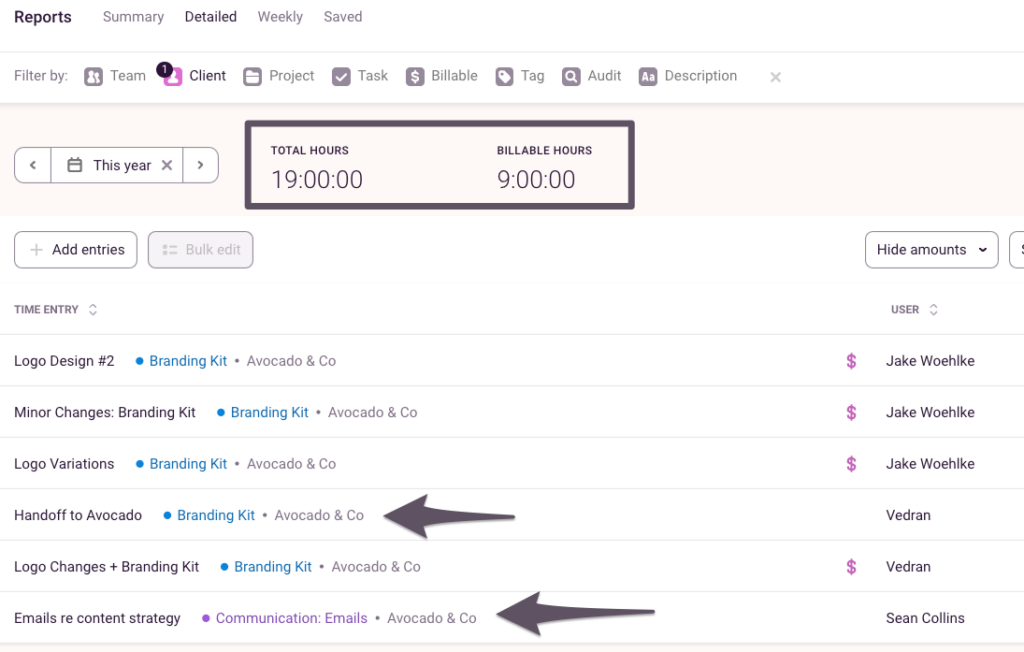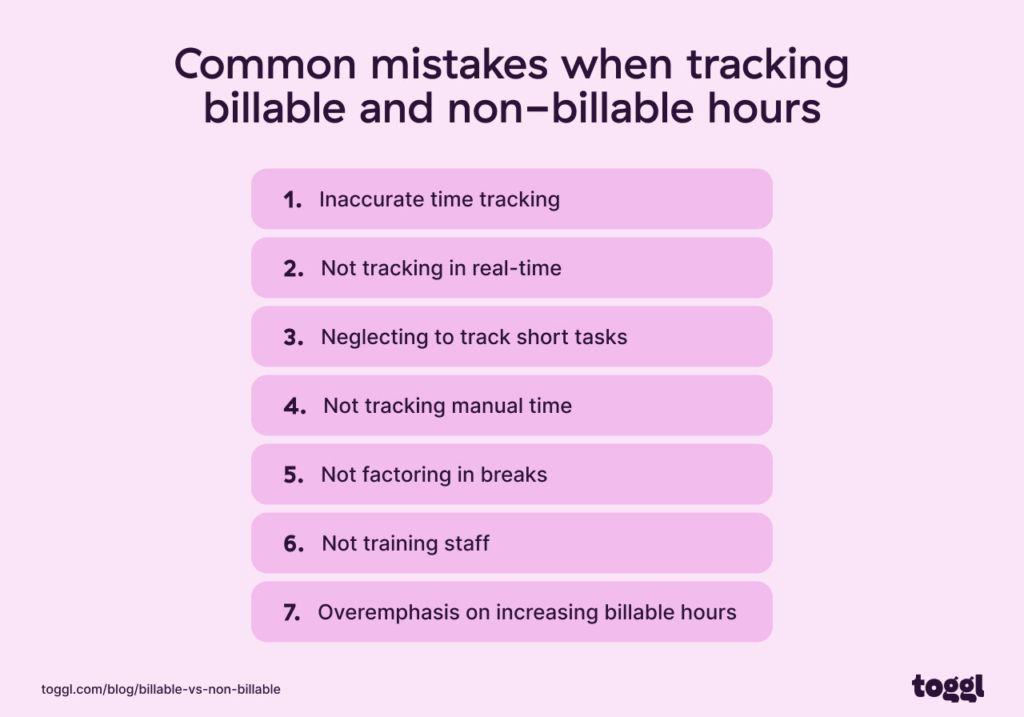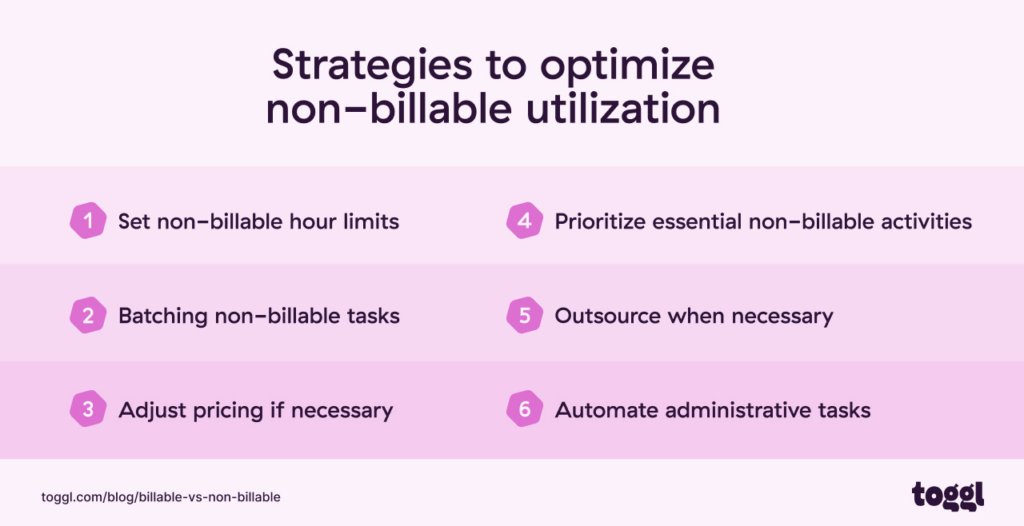Making a clear distinction between billable and non-billable hours is a critical skill for any agency owner, but especially those new to the game.
Such a lack of clarity in time and materials (T&M) projects can result in inaccurate invoicing and revenue loss.
For fixed-price projects, miscalculating hours can lead to overestimations, resulting in lost bids.
Alternatively, agencies can underestimate the total time needed to complete a project. This will often result in lower profit margins.
Navigating these differences, knowing the challenges, and understanding the best practices of billable and non-billable hours are paramount for agency owners since making mistakes in this area is almost always connected to losing money.
Knowing how to tell billable from non-billable hours helps ensure precise invoicing, competitive quoting, and ongoing organizational success.
This guide will help set the record straight and provide actionable insights for better work time tracking and management.
What is the difference between billable and non-billable hours?
The main difference is that billable hours are spent working on a client’s project, while non-billable hours represent time spent on administrative tasks such as meetings, training, etc.
But there are other factors to consider, like the billing rate, business impact, and priority.
| Billable hours | Non-billable hours | |
|---|---|---|
| Description | Total hours worked directly on client tasks and projects. | Total hours worked on non-project tasks. |
| Purpose | Complete client projects and generate income | Support business operations |
| Billing rate | Invoiced directly to the customer. Usually based on an hourly rate or fixed fee. | Not billed directly to customers. Typically absorbed by the company. |
| Business impact | Directly contributes to revenue and profit | Supports smooth business operations and improves an agency’s capability to deliver projects |
| Priority | Often top priority as they directly affect the bottom line and are time-sensitive. | Secondary to billable hours but still necessary for long-term success. |
Let’s go over billable and non-billable hours in more detail.
Billable hours
Billable hours are the hours your team spends delivering client-specific project tasks.
That’s why they’re chargeable directly to the customer.
Examples of billable hours
Here are some examples of billable tasks:
- Project planning, management, and other related tasks.
- Actual client work. This work includes the time spent on delivering the project — for example, research, designing, writing, coding, editing, etc.
- Creating project-related documents.
- Client meetings, consultations, phone calls, and other communications.
- Project deployment, training, etc.
Let’s now look at non-billable hours.
Non-billable hours
Non-billable hours are hours spent on administrative tasks and are not directly chargeable to any specific client.
However, they are essential to the business and generally in the form of internal operations.
Examples of non-billable tasks
Here are some examples of non-billable tasks:
- Internal meetings and training sessions.
- General administrative tasks include bookkeeping, filling out timesheets, and email communication.
- Business and employee development.
- Sales pitches or marketing activities not tied to any specific client.
- Any time spent on bids or proposals that weren’t accepted.
With these basic definitions in place, let’s look at the main challenges of tracking billable and non-billable hours.
Challenges in tracking billable and non-billable hours
It’s not always easy to track billable and non-billable hours efficiently.
You might experience some challenges along the way.

Let’s see why:
1. Lack of organizational standardization
With no clear ground rules and standardization on internal procedures, employees or departments may have different interpretations of billable vs. non-billable hours.
This lack of standardization can lead to inconsistencies.
Solution: Set up comprehensive documented guidelines related to timekeeping.
These instructions should include
- Clear and concise definitions of billable and non-billable hours, including typical examples
- Instructions on how to classify each type of activity, including guidelines on how to account for specific hours
If, for example, a team member works on multiple projects or attends a training event, they’ll need instructions on how to record their hours.
- Consider any contract or client specifics and communicate them to all relevant team members and stakeholders.
For example, it should be clear whether reporting project status is considered a billable or non-billable action.
2. Resistance to change
Not everyone embraces new time-tracking tools and strategies.
This reluctance is often visible in long-time employees who’ve gotten used to filling timesheets manually.
Solution: Leading by example is the right approach to changing long-term employee habits.
Don’t expect team members to do something you’re unwilling to do yourself.
You should also:
- Talk to your people about the benefits of time tracking. Make sure they see how it benefits them personally.
- Promote a work environment where employees feel encouraged to report their hours honestly.
3. Ease of use
Tracking billable and non-billable hours can be an extra hassle with a complicated time-tracking system.
Tools with cumbersome interfaces and intricate processes can result in frustration, errors, delays, decreased productivity, and even low tool adoption.
Solution: Avoid complicated time-tracking systems like manual timesheets. Go for streamlined and automated systems like Toggl Track, for example.
The time tracker you use should prioritize convenience and efficiency. This includes intuitive UIs and straightforward navigation. These allow users to log in their hours and activities quickly.
Automated reminders ensure timely entries, while customizable project and task categorization enhance accuracy.
Visual dashboards and real-time reporting provide quick insights, while integration with project management tools minimizes manual data entries.
A user-friendly time-tracking system should also include robust training resources to help minimize the learning curve for all users.
4. Data security concerns
Another challenge is data security.
You need to make sure that client information and project details are safe at all times.
Solution: Look for a secure time tracker.
Toggl Track, for example, creates full data backups every 24 hours. It also stores it in separate physical locations.
It also hosts sensitive data on the Google Cloud Platform (GCP). The GCP adheres to Cloud Security, Cloud Privacy, and Payment Card Industry (PCI) Security Standards, among others.
You know your data will be safe in their hands.
Thousands of businesses trust Toggl Track with their sensitive information, ranging from start-ups to Fortune 500 companies.
5. Cost implication
Small companies and start-ups, in particular, must keep a close eye on their bottom lines.
Many think investing in advanced time-tracking software systems might pose a cost-related challenge.
But that doesn’t have to be the case.
Solution: Toggl Track has a Free plan just for this situation.

It includes basic time-tracking features and allows up to five users to track their billable and non-billable hours.

This plan suits start-ups with small teams, freelancers, or solo users.
As the business grows, you can upgrade to a paid subscription to unlock more powerful features and add more users.
6. Disputes
Client disputes can become a severe problem if things are not clear from the start.
A lack of transparency or proof supporting billed hours can result in time-consuming client disputes.
At worst, you could even end up losing the client over it.
Solution: Set clear expectations with new clients before starting any project.
Tell them about your billing rates and how you track billable hours.
Be as transparent as possible about what tasks are billable and what aren’t.
7. Communicate with clients continuously
Like in personal relationships, constant communication and transparency are critical to a healthy business relationship.
In business, however, you can’t just go on trust alone. You need to prove your worth and justify your total billable hours at the end of the day.
Justifying billable hours can be a challenge if you don’t have a time tracking software.
Solution: Generate and share time reports with your clients.
Toggl Track makes it easy to generate summarized or detailed time reports.
The Summary report shows the total time tracked based on factors like user, client, project, task, etc.
These reports include easy-to-understand charts that show billable hours and non-billable hours.

The Detailed time report goes deeper into the data and shows each data entry.
Again, you can filter the Detailed report by User/Team, Client, Project, Task, Tag, Billable flag, or Description.

Both types of reports are great to keep your client in the loop. It lets them know exactly what they’re paying you for and in what amounts.
Why is it important to track both billable and non-billable hours?
Tracking billable and non-billable hours is critical for several reasons.
It builds client trust, improves financial management, and helps make better resource management decisions.
Also, in some countries, time tracking is essential for legal and regulatory compliance.
Yet, tracking employee hours and their utilization rate can prove challenging.
This challenge gets even more significant when you have a large team or work with third-party contractors.
Manual timesheets are inefficient.
Think of the hassle of sifting through all timesheet data and calculating total billable hours. All that time spent on this administrative work will end up in your non-billable column. 😣
Talk about inefficiency!
Toggl Track makes all this work a breeze.
The reporting dashboard lets you quickly see each project or client’s total billable and non-billable hours.
In the example below, of the total nineteen hours, nine are billable.
Only two tasks are non-billable: a handoff and some emails regarding content strategy.

It’s as simple as that!
Common mistakes when tracking billable and non-billable hours
It’s not uncommon for businesses to make mistakes when tracking their work time.

Let’s see what these are and how to avoid them best.
1. Inaccurate time tracking
Manual tracking methods are prone to error and can lead to inaccuracies.
Team members might round up or down or simply need to remember to log in billable hours. In either case, you’ll end up with inaccurate hours.
Solution?
Use a time-tracking tool to track your team’s billable and non-billable hours accurately.
- One-click timers to get your people tracking time immediately — no onboarding needed
- Automated time tracking for more accurate time entries
- Summary and Detailed reports to view, filter, and sort your data. You can also create dynamic reports so clients can track your work in real-time.
- Assign billable rates by employee, team, or project and see what’s generating revenue.
- Project estimates help you determine how actual work compares to your assessments.
- Get access to historical billable rates for better forecasting.
2. Not tracking in real-time
Waiting until the end of the day or week to log hours is a surefire way to end up with serious inaccuracies.
Real-time tracking is the way to go if you want to keep an accurate record of all activities as they happen.
The solution is to use a time tracker that lets you track time anytime and anywhere.
Toggl Track enables your team to track their time from the web app.
You can also track your work while browsing (browser extension shown below), using the desktop and mobile apps, or through third-party integrations.
Toggl also lets you track time even when you’re offline.

Toggl Track integrates with over 100 popular tools like Asana, GitHub, Slack, Google Docs, and Freshdesk. You can track time on any of these tools while working on your projects.
3. Neglecting to track short tasks
Many make the mistake of deeming short tasks as insignificant and brush them off.
Yet, a little bit here and there adds up over time.
With long enough projects, you could be looking at substantial unbilled work hours that can majorly impact your bottom line.
Accurate time trackers account for every moment of your employee’s work time.
4. Not tracking manual time
A standard error in tracking billable and non-billable time is not factoring in off-desk activities.
Off-desk activities can include meetings, answering emails after working hours, or anything else project or task-related that’s not usual day-to-day.
As with the short tasks example above, these activities can add up and lead to inaccurate time billing for your work efforts.
The solution here is to leverage a time-tracking system with mobile capabilities.
It lets you monitor your activities while on the go, even offline, ensuring good time tracking while away from the desk.
A flexible time tracker like Toggl Track allows manual time entries that you can enter later when you can. Whether you don’t have your time tracker or simply forgot, you can still add the work time into the system.
In addition, Toggl Track also connects with popular calendar applications and shows meetings and other events on the Timeline view. This feature makes it easy for you to add time entries later.
Combining these capabilities and manual data entries can ensure better time-tracking precision.
5. Not factoring in breaks
Say, an employee takes a few breaks during a task but fails to pause the time tracker.
What happens is you get billed for idle time.
With Toggl Track MacOS and Windows apps, team members get notified for any time they’ve been inactive or away for a predetermined number of minutes.
Whether it’s on sleep, shutdown, or inactivity detected, you can choose what to do when the notification pops up.
Here’s what the popup looks like.

When it appears, team members have four options to choose from:
- Discard idle time: You stop the running timer and discard the idle time.
- Discard idle and continue: You start a new time entry matching the previous one. It also ignores the idle time.
- Add idle time as a new time entry: You stop the running timer and add the idle time as a new entry.
- Keep idle time: You ignore the idle time and add it to the current time entry.
6. Not training staff
A big mistake many companies make is not to provide adequate employee training.
If team members don’t know the importance of time management or how to track their work time properly, they can experience consistent errors.
Your staff will also risk falling behind, becoming demotivated, and unproductive.
There’s also a high chance of burnout in this scenario.
The solution is to conduct regular training sessions on efficient time management and using time trackers effectively.
Both employees and managers need these training sessions.
Regular training will save you a lot of headaches down the road and improve your bottom line.
7. Overemphasis on increasing billable hours
It’s tempting to focus mainly on billable hours and neglect your non-billables.
After all, billable hours pay the bills.
But by trying to optimize total billable hours, you put essential non-billables on the back burner.
Non-billable activities like business development, employee training, internal team meetings, etc., are crucial to the company’s long-term sustainability and success.
Plus, your employees might feel overwhelmed and burnt out if there’s an unreasonable focus on billable hours.
The solution is to strike a balance between the two.
Here are several strategies to make the most of your non-billable hours.
Strategies to optimize non-billable utilization
There are six tried and tested strategies to help you strike the right balance between billable and non-billable hours.

Let’s see exactly how they work.
1. Set non-billable hour limits
A good rule of thumb is to set a maximum limit on your non-billable hours.
This strategy makes everyone more conscious about how they spend their time.
Say, for instance, a software-developing company decides to set limits on non-billable hours.
They review their essential non-billable hours and determine a reasonable limit like:
- Daily: 1 hour
- Weekly: 5 hours
- Monthly: 20 hours
The software developer determines these limits based on the type of work and the total number of billable hours they’re expected to do every day.
The company then communicates these limits to all relevant stakeholders.
It also explains the reason for these limits and how team members should track their non-billable hours.
With a time tracking system, staff members can easily classify their work time as billable or non-billable.
At the end of each month, the company analyzes the data and identifies those who exceed those limits.
They then meet to determine why the limits were exceeded and devise optimal ways to reduce that non-billable time.
This strategy lets people focus on billable work while not neglecting non-billable time.
2. Batching non-billable tasks
A second strategy is to group similar non-billable tasks.
For example, a marketing design agency has a list of essential non-billable activities it needs to complete each week.
These activities include employee training, internal meetings, and other administrative work.
The agency then decides to clump these up together by day like:
- Monday: All administrative tasks like emails, responding to clients, updating projects, etc.
- Tuesday: All internal and external meetings with team members, clients, vendors, partners, etc.
- Wednesday: All training activities like webinars, compliance training, time management training, etc.
By batching similar tasks together, your team doesn’t have to switch their context often. This technique helps them focus on similar tasks and finish more quickly.
3. Adjust pricing if necessary
Changing the pricing model on specific service offerings is sometimes good practice to optimize non-billable time utilization.
A consulting company, for example, will offer a service that’s in high demand but requires a lot of non-billable time to complete.
This could be developing custom solutions for clients.
To optimize its non-billable utilization, the consulting firm can adjust its pricing model to include the non-billable time for each service.
This way, non-billable hours are no longer a financial burden since the price includes these hours as well.
4. Prioritize essential non-billable activities
You should also identify and prioritize essential non-billable tasks. These include training, business development, or internal process optimization.
If you’re a digital agency, here’s how you can optimize your non-billables:
Start by identifying all non-billable activities your agency completes (i.e. admin work, training, networking, business development, marketing, etc.).
Evaluate each one and determine its impact on your business.
Consider these factors:
- Does it support the agency’s goals, mission, and vision?
- Is it essential for day-to-day operations?
- Does it help maintain or build the agency’s reputation?
- Does it help improve efficiency and profitability?
The more these boxes it checks, the more critical the non-billable activity is.
Focus on doing the essential ones first.
Keep in mind that the importance of non-billable activities can change with time.
As a result, it’s essential to regularly review the list of activities and make the necessary changes.
5. Outsource when necessary
Another helpful strategy is to outsource non-billable activities.
This strategy is beneficial for low-priority administrative tasks.
Outsourcing such non-billable tasks frees your employees to focus more on billable activities.
For example, a software development company might outsource administrative tasks like invoicing, bookkeeping, or payroll to an accounting firm.
6. Automate administrative tasks
Technology can help you streamline and automate many time-consuming tasks.
Think about things like scheduling, invoicing, or data entry.
You can even find software solutions that optimize employee training — i.e. learning management systems (LMS).
Another typical example is customer support.
A customer support provider can free up time answering by creating support docs or using an AI bot to answer common questions.
The less time spent on repetitive admin activities, the more you get to focus on billable time.
As a digital agency, you can automate your daily non-billable time as follows:
- Start by identifying what non-billable tasks you can automate. Think emails, reports, data entry, appointment scheduling, reminders, notifications, etc.
- Find the right digital tools to match these activities.
- Evaluate different options and choose those that best suit your business needs. Consider factors like must-have and nice-to-have features, ease of use, customer service, scalability, and cost.
- Implement those solutions. Keep in mind that you may need to develop new workflows.
You may also have to integrate these new tools with your existing systems. Your employees may also need some onboarding on how to use them effectively. - Lastly, monitor these newly automated tasks. Make sure they’re working as expected. It’s unlikely you’ll find the best workflow on your first try. You also may need to make adjustments as your needs change over time.
Track time and improve profits with the right tool
So, there you have it – the differences, challenges, mistakes, and best strategies for billable and non-billable hours.
The main takeaway is that both are important to your business.
And while billable hours generate revenue, non-billable time takes care of long-term maintenance.
If you want to automate your billable and non-billable time tracking, look no further than Toggl Track.
Sign up for a 30-day free trial and see how the time tracker makes your job much easier!
Frequently Asked Questions (FAQs)
Here are a few answers to your questions.
How many hours should be billable?
According to Drew McLellan of the Agency Management Insitute, “For most [marketing] agencies, the gold standard is that 75 percent of your total number of available hours should be spent on billable tasks.”
This means that, of the 40 work hours per week, roughly 30 should be billable.
This figure is not set in stone, however. You need to find the right balance between billable and non-billable time that works for your business.
Do you get paid for non-billable work?
The short answer is no — non-billable work is not paid directly by the customer.
That said, non-billable tasks are critical to the long-term success of any organization.
How can companies manage non-billable hours?
Some best practices include prioritizing critical non-billable tasks, automating admin tasks, and setting limits.
Well-trained employees excel at optimizing their time.
So, investing in periodic employee training also helps optimize non-billable hours.
Work tools to elevate your productivity – apps for incredibly simple time tracking and effective project planning.



